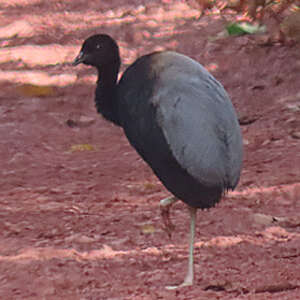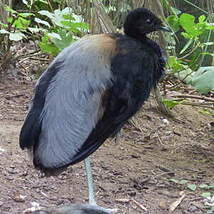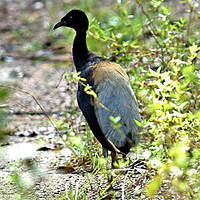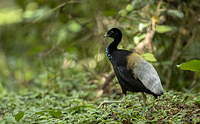Grey-winged Trumpeter
Psophia crepitans - Agami trompette
Identification
The Grey-winged Trumpeter is the size of a domestic chicken or pheasant. Its plumage is black except for the lower back which is grey-ash. A diffuse band of brown-red separates in the centre of its back the black of its upper part from the grey of its lower part. Its wings are strongly curved and always kept away from its body. Its tail is covered by its fluffy back feathers, which extend onto its rump, giving the bird its rounded and arched appearance. Its rather long and black neck has short metallic green and purple feathers. Its short and powerful beak, similar to a gallinaceous bird, together with its relatively long legs are greenish.
Subspecific information 3 subspecies
- Psophia crepitans crepitans (Venezuela and se Colombia through the Guianas and n Brazil)
- Psophia crepitans napensis (se Colombia to ne Peru and nw Brazil)
- Psophia crepitans ochroptera (nc Brazil)
Foreign names
- Agami trompette,
- Trompetero aligrís,
- jacamim-de-costas-cinzentas,
- Grauflügel-Trompetervogel,
- szürkeszárnyú dobosdaru,
- Trompetvogel,
- Trombettiere aligrigie,
- gråvingad trumpetare,
- Gråvingetrompetfugl,
- trubač agami,
- trubač agami,
- Grårygget Trompetérfugl,
- kyssäkurki,
- trompeter alagrís,
- gruchacz siwoskrzydły,
- Сероспинный трубач,
- ラッパチョウ,
- 灰翅喇叭声鹤,
- gråvingad trumpetare,
- 灰翅喇叭鳥,
Voice song and call
The Grey-winged Trumpeter usually produces a very nasal sound. A kind of chuckling sound which can phonetically be represented as a series of close whu whu which gradually get louder, ending with a soft sound before repeating itself. Another of its calls is comparable to the chopping sound produced by guineafowl.
Habitat
Behaviour character trait
The Grey-winged Trumpeter is a terrestrial bird that lives in groups of six to twenty individuals. They peck the ground of the forest together.
Each member of the group contributes to the safety of all. It is skilled at running, but it does not fly very well. If it feels threatened it can use flight to cross a river but it will finish its crossing by swimming. It perches in flocks at a low height to escape predators. This gregarious animal is mainly active at night and in rainy weather. Flocks of Grey-winged Trumpeters often follow groups of arboreal animals to take advantage of the fruits and nuts they drop. This unafraid bird is often domestic and used as a shepherd dog to guard poultry or even other animals.Flight
Dietfeeding habits
Reproduction nesting
Before mating, the male and female perform a parade. This consists of loud dances accompanied by jumps and various acrobatics.
The male emits his cry, similar to that of a trumpet, to seduce the female. At other times they call each other softly while smoothing out the feathers on their head and neck. The mating parades are often performed in a group.The breeding season is poorly known in the wild. Only a few females from the group (or even only one) lay eggs. The laying female practices polyandry. The Grey-winged Trumpeter nests on the ground in dense forests or in a tree hole. The female can lay up to ten green or cream-white eggs. The dominant male, assisted by other group members, feeds the female during the incubation period which lasts about a month.
Geographic range
Threats - protection
IUCN conservation status
concern
in the Wild
threatened
evaluated
This bird, the victim of intensive hunting, has declined significantly in recent years. It can now be found almost exclusively in deep forests, where they have found refuge. It has disappeared from the vicinity of villages and the coastal strip. The rampant deforestation is further reducing their distribution area. Although this species is not yet threatened, the lack of regulation is worrying.
Sources of information
- IOC World Bird List (v14.2), Gill, F and D Donsker (Eds). 2024-04-18.
- Vol. 3 - Handbook of the Birds of the World, Josep del Hoyo-Andrew Elliott-Jordi Sargatal
- Avibase, Lepage Denis
- Birds in Suriname, South America, Jan Hein Ribot
- CREAGUS@Monterey Bay, Don Roberson
- Wikipédia, Wikipedia, The Free Encyclopedia
Other sources of interest
 Specification sheet created on
03/08/2023 by Jean-Pierre Trouillas
Specification sheet created on
03/08/2023 by Jean-Pierre TrouillasTranslation by AI Oiseaux.net
© 1996-2025 Oiseaux.net
- Accipitriformes
- Aegotheliformes
- Anseriformes
- Apodiformes
- Apterygiformes
- Bucerotiformes
- Caprimulgiformes
- Cariamiformes
- Casuariiformes
- Charadriiformes
- Ciconiiformes
- Coliiformes
- Columbiformes
- Coraciiformes
- Cuculiformes
- Eurypygiformes
- Falconiformes
- Galliformes
- Gaviiformes
- Gruiformes
- Leptosomiformes
- Mesitornithiformes
- Musophagiformes
- Nyctibiiformes
- Opisthocomiformes
- Otidiformes
- Passeriformes
- Pelecaniformes
- Phaethontiformes
- Phoenicopteriformes
- Piciformes
- Podargiformes
- Podicipediformes
- Procellariiformes
- Psittaciformes
- Pterocliformes
- Rheiformes
- Sphenisciformes
- Steatornithiformes
- Strigiformes
- Struthioniformes
- Suliformes
- Tinamiformes
- Trogoniformes




























